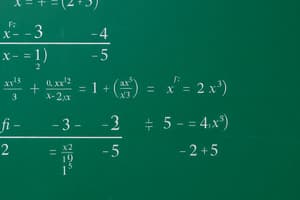Podcast
Questions and Answers
What is the principal square root of 64?
What is the principal square root of 64?
8
Define the term 'imaginary unit' in the context of square roots.
Define the term 'imaginary unit' in the context of square roots.
The imaginary unit, represented by i, is the square root of (-1) and is used in complex arithmetic operations.
If a number is 100, what are the values of its positive and negative square roots?
If a number is 100, what are the values of its positive and negative square roots?
Positive square root: 10, Negative square root: -10
Explain the difference between a principal square root and a non-principal square root.
Explain the difference between a principal square root and a non-principal square root.
What is the principal square root of 121?
What is the principal square root of 121?
Calculate the non-principal square root of -16.
Calculate the non-principal square root of -16.
Study Notes
Factorization: Understanding Square Roots
Factorization is a fundamental concept in mathematics, particularly in algebra, where it involves finding the factors of a given number. In this context, we will focus on understanding factorization with regards to square roots.
Square roots are the inverse operation of squaring numbers. They can be found by taking the root of a number raised to the power of two. For example, the square root of 9 (also called the principal square root) is 3 because 3 × 3 = 9. A non-zero real number a has exactly two values such that a * a = b. These values are called the positive and negative square roots of b, denoted by √b and −√b, respectively.
Let's break down some important terms related to square roots:
- Principal square root: This term refers to the positive value obtained when calculating the square root of a number. For instance, the principal square root of 25 is 5 since 5^2 equals 25.
- Nonprincipal square root: If you calculate both the positive and negative square roots, one of them (the non-positive) is called the non-principal square root. For example, if a number is -81, its principal square root is -9, but another possible solution is 9 (non-principal square root).
- Imaginary unit: The imaginary unit, represented by i, is used in complex arithmetic operations involving square roots. It is defined as the square root of (-1) and is 1 unit above the y-axis in the complex plane.
When dealing with complex numbers, like i, we can find the square root using a technique called De Moivre's formula, which states that:
[ \sqrt{z} = \cos{\left(\frac{1}{2} \pi\right)} + i\sin{\left(\frac{1}{2} \pi\right)} ]
In summary, factorization plays a crucial role in understanding the properties of numbers. With respect to square roots, they represent the inverse operation of squaring and have applications across various mathematical domains.
Studying That Suits You
Use AI to generate personalized quizzes and flashcards to suit your learning preferences.
Description
Explore the fundamental concepts of factorization and square roots in mathematics. Learn about principal and nonprincipal square roots, as well as the imaginary unit in complex numbers. Discover how factorization ties into understanding the properties of numbers and the inverse relationship with squaring.




